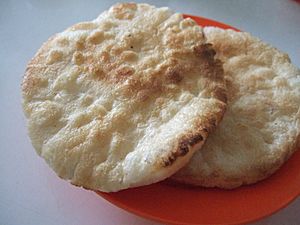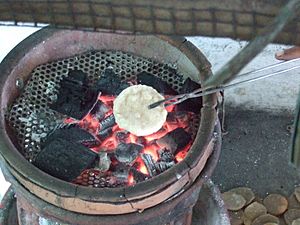Kemplang facts for kids

Kemplang cracker from Bandar Lampung
|
|
| Type | Snack |
|---|---|
| Place of origin | Indonesia |
| Region or state | Palembang in South Sumatra, Lampung and Bangka Belitung |
| Main ingredients | Wahoo or Spanish mackerel, tapioca flour |
Kemplang is a tasty traditional fish cracker from Indonesia. It's a popular snack found mostly in the southern parts of Sumatra. Kemplang crackers are usually made from ikan tenggiri (which is a type of wahoo or Spanish mackerel fish). This fish is mixed with tapioca starch and other yummy flavors. After mixing, the dough is dried in the sun and then grilled or fried.
Kemplang looks a bit like the Japanese senbei cracker. It's flat and round, usually a whitish color. Sometimes, it has dark, slightly burnt spots from being grilled. People often eat Kemplang with a sour and spicy sambal chili paste. It adds a great kick to the flavor!
What is Kemplang and Where Does it Come From?
The name kemplang comes from a local language in southern Sumatra. It means "to hit." This name refers to how the cracker dough is flattened during its making. Kemplang first came about in coastal towns in southern Sumatra. These areas include the provinces of South Sumatra, Bangka Belitung, and Lampung.
In Palembang, making kemplang is often connected to making another famous food called pempek. This is because both snacks use very similar main ingredients: wahoo fish and tapioca. In Palembang and Bangka, kemplang crackers are usually fried. But in Lampung, they are more often grilled over hot charcoal.
Kemplang is a popular oleh-oleh (a food gift or souvenir) for people visiting Palembang, Bandar Lampung, or Bangka. Today, kemplang made by small businesses in southern Sumatra is sold everywhere. You can find it in markets and supermarkets in big Indonesian cities like Jakarta and Surabaya.
Where is Kemplang Made?
Kemplang is mostly made by small, local businesses. These are found in Palembang, Bandar Lampung, and Bangka island. In Palembang, people buy a lot more kemplang crackers during the lebaran (Eid ul-Fitr) holiday. It's a special treat for celebrations!


